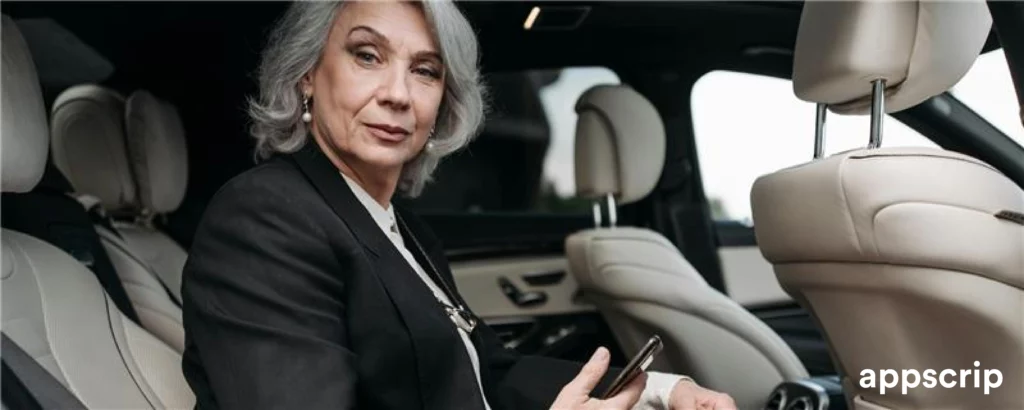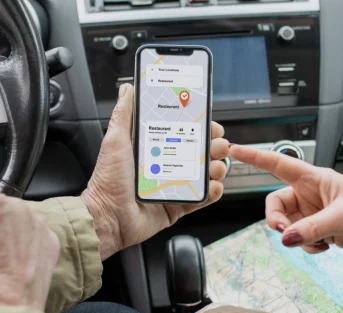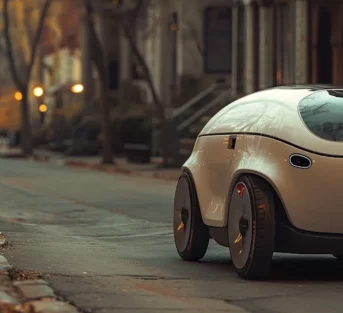With a significant portion of the world population projected to shift to urban areas by 2050, it goes without saying, transportation needs to up its game to ensure quality of life. And the magic pill that can make a difference, Robotaxis. Period.
Robotaxis are a blend of autonomous tech with ride-hailing convenience, that mitigates congestion, enhances safety, and cuts emissions—ingredients to efficient, smart, sustainable cities.
Robotaxi app development is pivotal and can reshape commuting. From backend algorithms that manage fleet logistics to real-time user interfaces for a smooth ride experience, the development of such apps is pioneering, progressive, and highly impactful.
TL;DR
Robotaxis are autonomous vehicles that enhance urban living by reducing congestion, emissions, and improving safety. Key players in the domain are Waymo, Cruise, Baidu Apollo Go, Zoox, and Motional.
- Essential Features:
- User Interface and Experience: Intuitive design, real-time feedback, and customization options.
- Safety and Security: Identity verification, ride monitoring, incident detection, and data protection.
- Integration with Autonomous Vehicles: Bi-directional communication, AV management APIs, remote assistance, and fleet synchronization.
- Development Steps:
- Research and Planning: Market research, user personas, and goal setting.
- Technical Development: Choosing the right tech stack and suggested app architecture.
- Prototyping and Testing: MVP build, simulation testing, real-world pilots, and feedback loops.
- Compliance and Legal: Licensing, insurance, data privacy, and accessibility.
- Challenges and Solutions:
- Technological Challenges: Address connectivity issues with edge computing and 5G.
- Market and Adoption Challenges: Build trust, enhance user experience, and use data-driven marketing.
Understanding the Robotaxi Ecosystem
What is Robotaxis?
Robotaxis are autonomous vehicles that transport passengers without a human driver. Powered by advanced AI, sensor fusion, and real-time data processing, these vehicles operate via pre-programmed navigation systems combined with real-time decision-making capabilities.
Robotaxis help:
- Reduce dependence on personal vehicles
- Minimizes traffic through shared mobility
- Lowers emissions being EVs
- Makes streets safer streets through precision driving
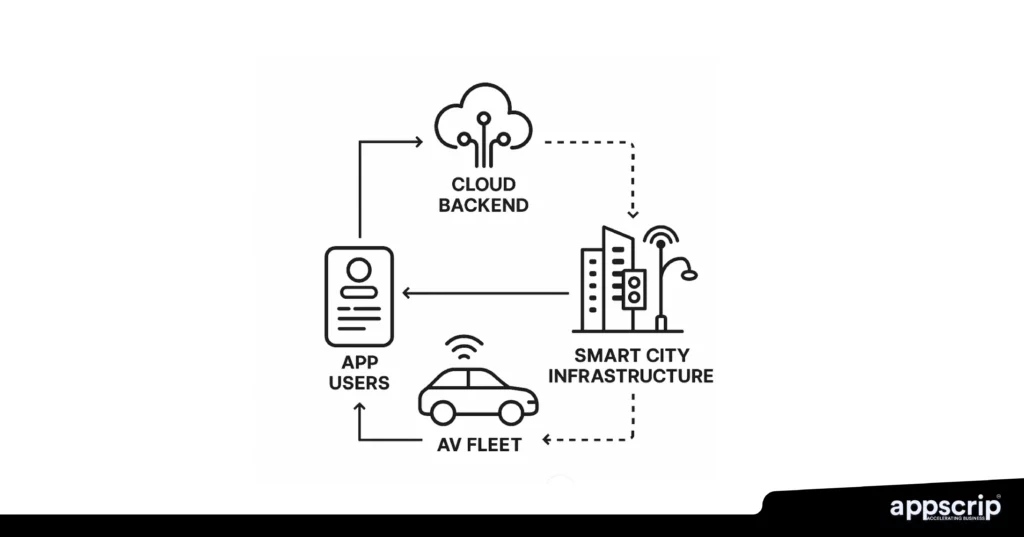
Key Players in the Robotaxi Market
The robotaxi sector is gaining momentum, with both tech giants and agile startups investing heavily in R&D, pilot programs, and commercial launches.
Major Players:
- Waymo – Backed by Alphabet, it’s one of the earliest pioneers in robotaxi services with operations in multiple US cities.
- Cruise – Owned by General Motors, Cruise is deploying fully autonomous rides in select urban zones.
- Baidu Apollo Go – A leader in China’s autonomous ride-hailing sector, with government partnerships and mass-market aspirations.
- Zoox (Amazon) – Focused on purpose-built autonomous vehicles with bidirectional driving and futuristic design.
- Motional – A Hyundai-Aptiv joint venture, known for partnerships with Lyft for pilot robotaxi services.
Essential Features of a Robotaxi App
User Interface and User Experience
UI/UX design directly impacts usability, user satisfaction, retention, and overall app success. A well-designed UI/UX ensures user adoption and retention. In robotaxi app development or mobile app development, where the concept of a driverless ride may be new to many, intuitive navigation and a sense of control/ease becomes rudimentary.
- Intuitive Design: The interface should be clean, minimalistic, and easy to navigate—even for users unfamiliar with autonomous tech. Key actions like booking a ride, tracking the robotaxi, or reaching support should be accessible in the least number of taps.
- Real-time Feedback: Users expect updates like estimated time of arrival, vehicle location, and progress tracking during the trip.
- Customization Options: Support for features like language preferences, accessibility settings (text-to-speech, high-contrast mode), preferred temperature/music in the vehicle, and ride preferences (solo/shared) enhances inclusivity and user satisfaction.
Safety and Security Measures
With no human driver onboard, users must feel inherently safe during every interaction either with the app or the vehicle.
- User Identity Verification: Secure onboarding is key, and this is done through KYC processes, biometric login, and OTP-based phone/email verification as it ensures trust.
- Ride Monitoring: Live ride tracking is another feature that is liked by most users. This is for users and their emergency contacts, and should ideally come along with built-in SOS buttons that trigger immediate alerts to central monitoring teams.
- Incident Detection and Response: Being ready for anything is imperative. Hence, the app should be integrated with the vehicle’s sensors to detect collisions, unusual stops, or unauthorized access. This should be followed by immediate response workflows—like sending alerts to authorities or deploying support—are critical.
- Data Protection: It goes without saying that compliance with data privacy regulations (GDPR, CCPA) is essential. All personal and ride data should be encrypted in transit and at rest.
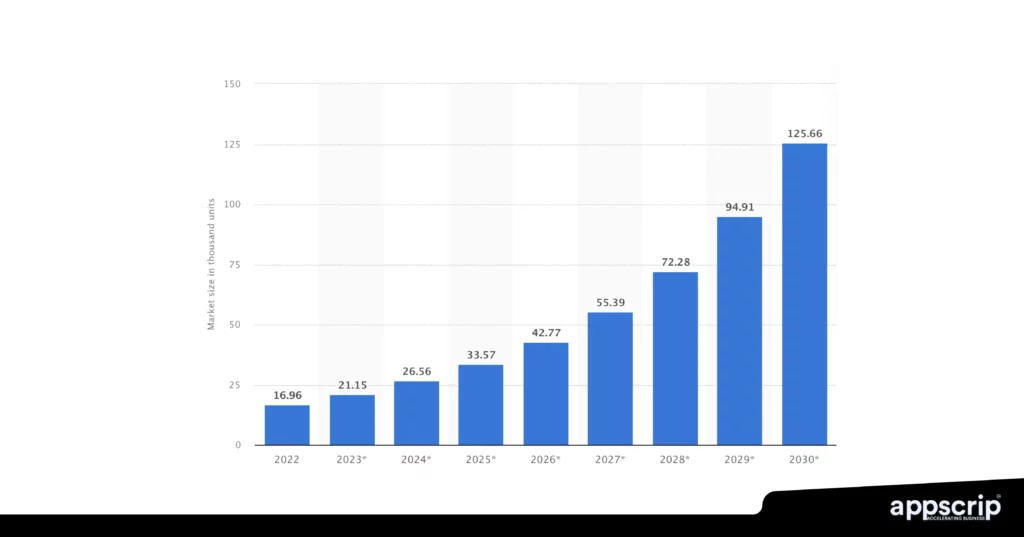
Autonomous vehicle market size and projection – Source Statista
Integration with Autonomous Vehicles
The success of any robotaxi app can be ensured only when there’s seamless communication with autonomous vehicles (AVs), warranting precise control and consistent user experiences.
- Bi-directional Communication: For several actions to flow without hiccup, the app must constantly exchange data with the AV. This would be ideally to manage actions like vehicle arrival, door unlocking, route updates, and ride status.
- AV Management APIs: Integration with vehicle APIs (like those offered by Waymo, Baidu Apollo, or proprietary AV platforms) to access telemetry, diagnostics, and perform control functions (start/stop, climate control, etc.).
- Remote Assistance Integration: In certain situations it would deem necessary that remote operators might need to take control or assist the AV. Therefore it is important that the app should have logic to support human-in-the-loop scenarios.
- Fleet Synchronization: Real-time syncing between app logic and fleet availability is vital. This is to ensure optimal dispatching, ride pooling, and predictive demand balancing.
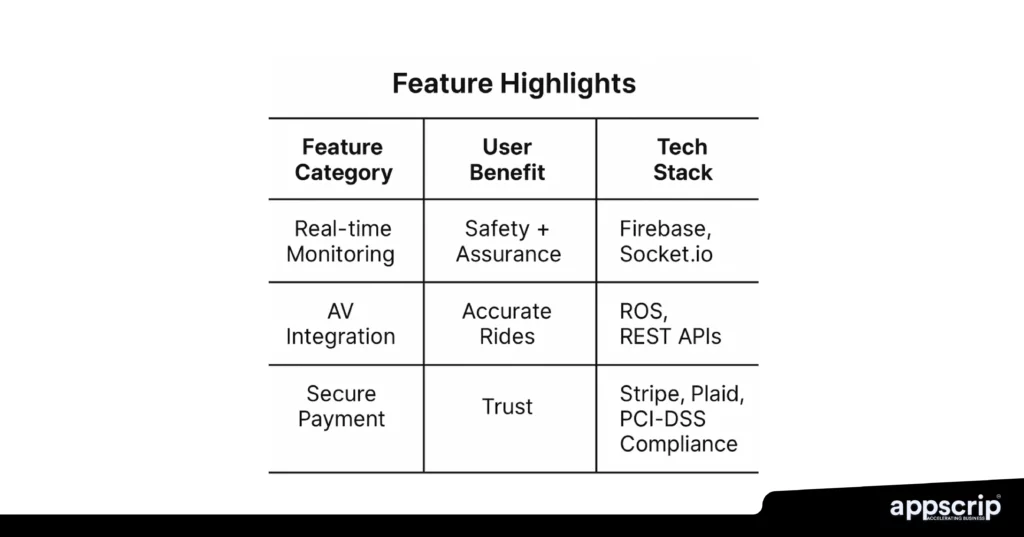
Steps to Develop a Robotaxi App
Research and Planning
Before starting to code, it’s crucial to fathom the requirements of the project. This should begin with understanding the market and having clear objectives.
- Market Research & Competitor Analysis: One of the easiest ways to do this is to identify leading robotaxi services for example: Waymo One, Cruise, Baidu Apollo Go, then study their app offerings, user experience, geographic coverage, and pricing models. After you have studied them in detail you would be able to pinpoint service gaps and user pain points.
- User Personas: Another basic metric to take into consideration would be to define your primary users—urban commuters, elderly users, tourists, etc. After that you can tailor the features of your app accordingly.
- Goal Setting: Establishing clear KPIs to key to keep on track as well as to know where you stand. KPIs such as:
- Number of active rides per day
- User acquisition rate post-launch
- Ride completion success rate
- App latency and uptime targets
This phase would help you to determine the business model, roadmap, and core differentiators of your product.
Technical Development Process
The development phase combines software engineering, data integration, and vehicle communication systems.
Choosing the Right Tech Stack
| Component | Recommended Technology |
| Frontend (Mobile) | Flutter / React Native (for cross-platform development) |
| Backend | Node.js, Python (Django/FastAPI), or Go (for performance) |
| Database | PostgreSQL, MongoDB |
| Real-time Data Layer | Firebase, MQTT (for lightweight AV communication) |
| Cloud Infrastructure | AWS / Google Cloud / Azure |
| CI/CD & Testing | GitHub Actions, Jenkins, Appium, Selenium |
| AV Integration APIs | Custom OEM SDKs, REST/WebSockets, ROS (Robot Operating System), APIs for sensor fusion (LiDAR, cameras) |
| Mapping & Routing | Mapbox, OpenStreetMap + custom AV navigation layers, Integration with HD maps (HERE, Google Maps API) and real-time traffic data. |
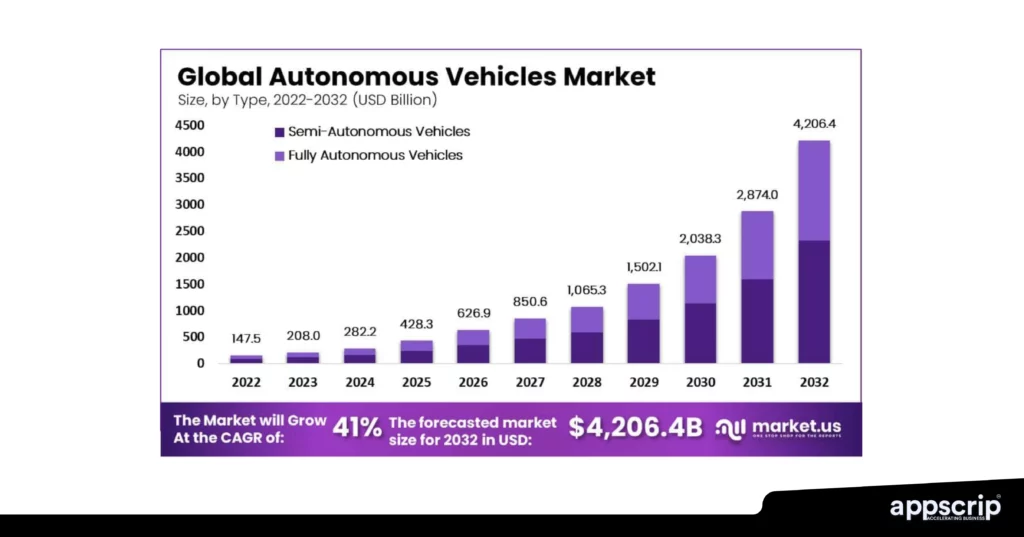
Suggested App Architecture
A Microservices-based architecture is ideal for robotaxi apps, allowing scalability, real-time performance, and modular development:
| [Client App] | ||
| ↕ | ||
| [API Gateway] | ||
| ↕ | ||
| [User Service] | [Ride Booking Service] | [Vehicle Control Service] |
| ↕ | ↕ | ↕ |
| [Database] | [Fleet Engine] | [AV Communication Layer] |
- API Gateway: Routes all requests securely and handles authentication.
- Fleet Engine: Optimizes vehicle allocation, ETA prediction, and pooling.
- AV Layer: Interfaces with autonomous vehicles via secure, real-time APIs.
- Monitoring Layer: Tracks rides, detects anomalies, triggers human intervention if needed.
Prototyping, Testing, Iteration
- MVP Build: This is basic to any development to hold cost in place and to ensure a successful product. Launch with a simple set of features—user registration, booking, tracking, and AV control.
- Simulation Testing: Testing is key to any product release. Use virtual environments to simulate various edge cases before live deployment.
- Real-World Pilots: For AV testing, controlled environs need to be selected. Deploy in controlled zones (e.g., tech campuses, private industrial parks) to fine-tune performance.
- Feedback Loop: To ensure there are not many hiccups and issues. Continuously gather rider and vehicle data to iterate on UI/UX, algorithms, and safety protocols.
Compliance and Legal Considerations
Compliance with regulations is key or you could end up facing legal hassles or even punitive damage. And regulations are critical when deploying autonomous vehicles for public use.
- Licensing and Permits: Be sure to secure necessary approvals from local transportation authorities or road safety bodies. Countries like the US, China, and Germany have specific AV testing and deployment zones.
- Insurance: It is always a good idea to be covered for eventualities. Ensure coverage for vehicle, rider, and third-party liability, especially in jurisdictions where driverless rides are still new.
- Data Privacy: Comply with global standards like GDPR, CCPA, and local surveillance regulations. Riders must have access to privacy settings and data control options.
- Accessibility & Ethics: It is imperative to provide a level playing field when offering services to the general public. Therefore ensure your app supports accessibility guidelines (WCAG), non-discrimination in ride allocation, and data transparency.
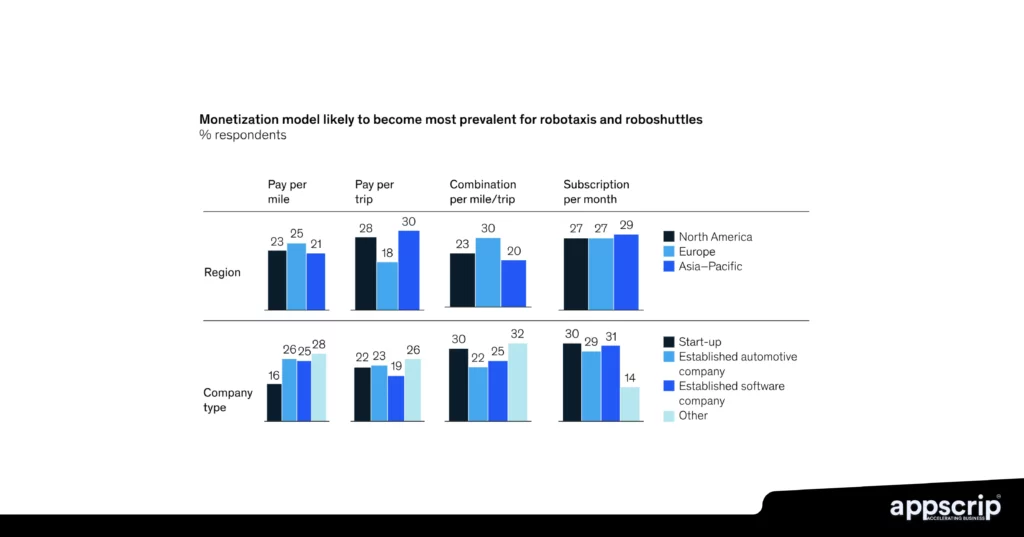
Possible monetization models that could be successful for robotaxis
Challenges and Solutions in Robotaxi App Development
Technological Challenges
Addressing Connectivity and Integration Issues
It goes without saying that the secret sauce to the success of Robotaxi’s future will be internet connectivity. Robotaxi apps depend on real-time data exchange between users, vehicles, and backend systems. Any lag or breakdown in connectivity can result in ride failures, navigation errors, or unsafe conditions.
Solution:
- One of the straightforward solutions will be implementation of edge computing to reduce latency by processing data locally within the AV.
- Use 5G or hybrid communication models (LTE fallback) to maintain high-speed, low-latency connectivity.
- Build redundancy into vehicle–server communication using MQTT/WebSockets + REST as backup.
Overcoming Limitations of Current Autonomous Technology
Current autonomous technology systems face limitations in safety, reliability, weather conditions, unpredictable pedestrians, data security, construction zones, ethical considerations, and societal acceptance. All of which can impede their widespread adoption.
Solution:
- Integrate real-time sensor fusion from cameras, LIDAR, and radar for accurate environment modeling.
- Partner with AV providers actively improving AI/ML-based perception and decision-making.
- Include remote human assistance systems for Level 4 autonomy edge-case overrides.
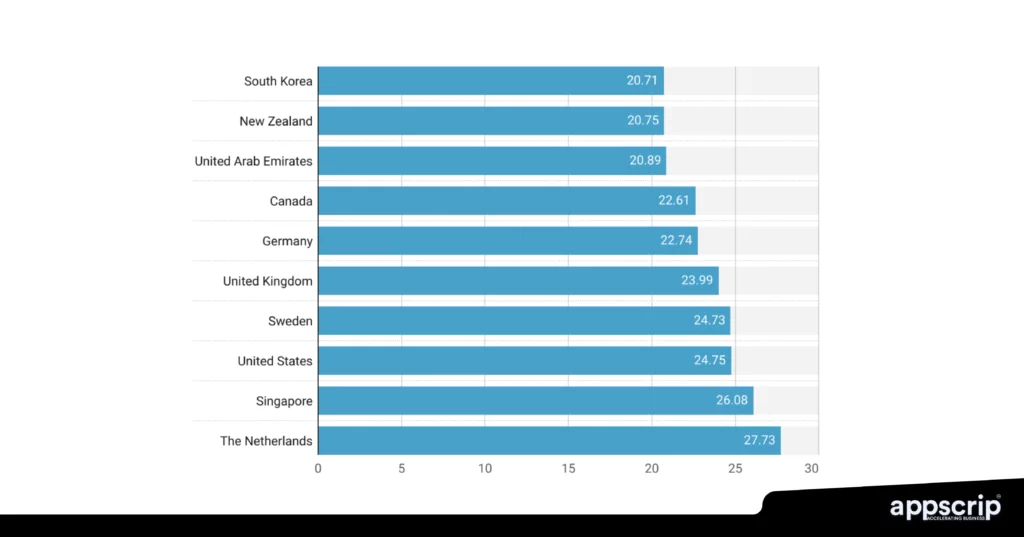
Index scores on Level of preparedness for driverless cars
Market and Adoption Challenges
Strategies for Market Penetration and User Acquisition
Robotaxis face intense competition from both traditional ride-hailing apps and public transportation.
Here’s a breakdown on various challenges AVs can face in the market and strategies on how they can overcome such issues.
| Category | Strategies |
| Building Trust and Addressing Concerns | |
| Safety First | Highlight safety features and testing procedures. |
| Transparency and Education | Clarify AV technology and address misconceptions. |
| Pilot Programs and Early Adopter Focus | Launch AV services in controlled environments. |
| Partnerships with Established Brands | Collaborate with reputable companies. |
| Enhancing User Experience and Convenience | |
| Comfort and Entertainment | Design comfortable interiors with entertainment options. |
| Seamless Integration | Provide easy access through remote features and mobile apps. |
| Personalized Services | Offer customized experiences based on user preferences. |
| Data-Driven Marketing and Targeted Campaigns | |
| Leverage Data Analytics | Analyze consumer data for targeted marketing. |
| Personalized Messaging | Craft messages that resonate with specific user segments. |
| Social Media and Influencer Marketing | Use social media and influencers to build awareness. |
| Content Marketing | Create informative content to educate potential customers. |
| Market Penetration Strategies | |
| Competitive Pricing | Offer competitive pricing to attract price-sensitive customers. |
| Accessibility and Convenience | Ensure AVs are easily accessible with flexible payment options. |
| Targeting Competitor Customers | Acquire customers familiar with similar products. |
| Loyalty Programs | Implement reward systems to encourage repeat business. |
Building Trust and Awareness Among Potential Users
Users may be skeptical of handing over control to a machine, especially in safety-critical scenarios.
Solution:
- Implement visible safety features like live ride tracking, emergency buttons, and ride recording options.
- Showcase transparency through real-time AV decision feedback (e.g., “Stopping for pedestrians”).
- Offer guided demo rides or in-app simulations to help users acclimate to AV experiences.
Conclusion: Robotaxi App Development
Robotaxi apps will play a pivotal role in the smart cities of tomorrow as AVs will enable safer and more accessible transportation, cut emissions and ease urban congestion.
Whether you’re an entrepreneur / startup venturing into the mobility space or a traditional player looking for the right investment, this is the time to board the autonomous ride-hailing wave. With thoughtful planning, cutting-edge technology, go ahead and launch a Robotaxi app as it can transform urban mobility.
We at Appscrip specialize in helping businesses build future-ready mobility solutions. With our proven track record in developing scalable, high-performance ride-hailing platforms, we combine deep domain expertise with advanced tech capabilities.
If you’re looking to bring your Robotaxi vision to life, we can be your ideal technology partner. Get in touch.

